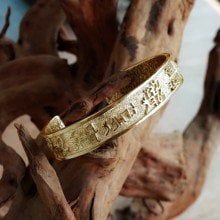
Ancient Priestly Blessing Gold Bracelet
With the priestly blessings in the ancient Hebrew - the Paleo Hebrew alphabet
Amulet to ward off evil and also symbolizes the divine love of the creator
A few weeks ago during a visit to Jerusalem my youngest son who loves archeology asked me to take him to the Israel Museum, to visit the latest exhibition and to see the incredible collection of artifacts and archeological findings from the rich history of the region.
There are also a few permanent exhibitions that take the visitor through a journey in time and make each one a sort of a time traveller. You begin your journey at the early human settlements that were found here in Israel, through the Chalcolithic period, the various nations and people of the region, and of course the ancient kingdoms of Israel and Judea.
It is an unbelievable display with actual artifacts bearing the names of various figures and biblical kings and one can even trace many ancient traditions that are still alive today.
One of the exhibits that caught my attention was a small silver scroll that is part of the Ketef Hinnom Scrolls that were found in an archaeological site discovered in the 1970s southwest of the Old City of Jerusalem. That specific scroll is an ancient amulet from the 7th century BC from the First Temple period, containing the ancient Priestly Blessing.
It is the earliest known artifact written in ancient Hebrew-the Paleo Hebrew alphabet which is the writing system found in Canaanite inscriptions from the region of biblical Israel and Judah. It is fascinating to see that this thousand of years old tradition still exists today in the same manner.
That was also one of the reasons that I decided to create three new amulets in the form of a ring, bracelet, and pendant. The Priestly blessing is an ancient Hebrew prayer recited by the Hebrew priests - the Kohanim who are the direct descendants of Aaron (Each one that carries the name Cohen in different variations is a direct descendant with ancestry that goes back thousands of years).
The text of the blessing is found in Numbers 6:23–27.
According to the Torah, Aaron who was the first high priest blessed the people of Israel and God promises that "They (the Priests) will place my name on the Children of Israel, meaning that they, the priests will carry the blessing, and I will bless them". The Chazal stressed that although the priests are the ones carrying out the blessing, it is not them or the ceremonial practice of raising their hands that results in the blessing, but rather it is God's desire that the blessing should be symbolized by the Kohanim's hands.
This ritual/practice continued even after the destruction of the second Temple in Jerusalem, in Jewish synagogues, and can be found in any Jewish community during the prayer.
The translation of the text and its meaning goes as follows:
(May) God (YHWH) bless you and keep you
[May] YHWH make His face shine on you, and show you favour
[May] YHWH lift His face to you, and give you peace
The blessing was inscribed in ancient times as an amulet to ward off evil and it also symbolizes the divine love of the creator and must be performed by the priests who symbolize peace and spirituality.
The ritual is performed when the priests raise their hands and spread their fingers in such a way that they create the four letters of the sacred name of God actually in the same ancient Hebrew fonts - (YHWH) and also the three letters (Sheen, Dalet and Yod) which are the initials of "Shomer Daltot Israel) the Guardian of the doors of Israel.
I've created these three pieces with the exact same fonts that were used thousands of years ago.
Fun fact: the actor Leonard Nimoy, who was raised in a traditional Jewish home, and is a Cohen used a single-handed version of the Priestly Blessing gesture to create the Vulcan salute when he portrayed Spock on Star Trek with the "Live long and prosper" greeting…